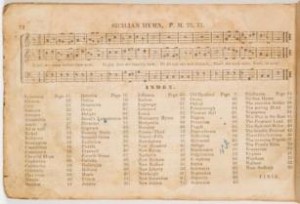Johnson, Andrew W. The Eclectic Harmony. Revised and improved second edition. Shelbyville, Tenn.: N.O. Wallace & Co., Printers, Shelbyville Free Press Office, 1847.
 Only one other copy is known of this title, and that was purchased in 2001 by the Center for Popular Music at Middle Tennessee State University. Then just this past year a private individual discovered a second copy when sorting through hundreds of books in her mother-in-law’s Tennessee attic. This newly-discovered copy is in better condition than the other. It is complete, in a wallpaper wrapper, and includes an index at the end listing all the hymn tunes. The owner of this copy contacted the Center for Popular Music, but as they already had a copy, the director Dale Cockrell kindly suggested AAS might be the right home for it.
Only one other copy is known of this title, and that was purchased in 2001 by the Center for Popular Music at Middle Tennessee State University. Then just this past year a private individual discovered a second copy when sorting through hundreds of books in her mother-in-law’s Tennessee attic. This newly-discovered copy is in better condition than the other. It is complete, in a wallpaper wrapper, and includes an index at the end listing all the hymn tunes. The owner of this copy contacted the Center for Popular Music, but as they already had a copy, the director Dale Cockrell kindly suggested AAS might be the right home for it.
Here is how the Center for Popular Music described what was, at the time they acquired it, the only copy of a previously unknown central-Tennessee shape-note tunebook:
Eclectic Harmony represents the shape note system of music notation, which developed in the early 19th century. The system is historically associated with the Singing School Movement, a reform movement to raise standards of singing in Protestant churches in the Northeast. Between 1810 and 1820, the shaped notation as well as the style of folk hymnody it embodied fell out of favor in the North. But it continued to thrive in the rural South and West. Folk hymns in shape notation are among the earliest known music publications to carry a Tennessee imprint. Little is known of Eclectic Harmony‘s publisher, Andrew Johnson, other than he seems always to have lived in Middle Tennessee. He compiled at least two other shape note collections, The American Harmony (1839) and The Western Psalmodist (1853), both published in Nashville.
